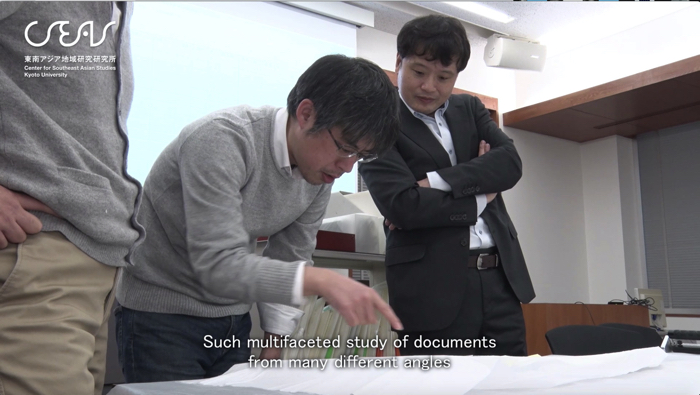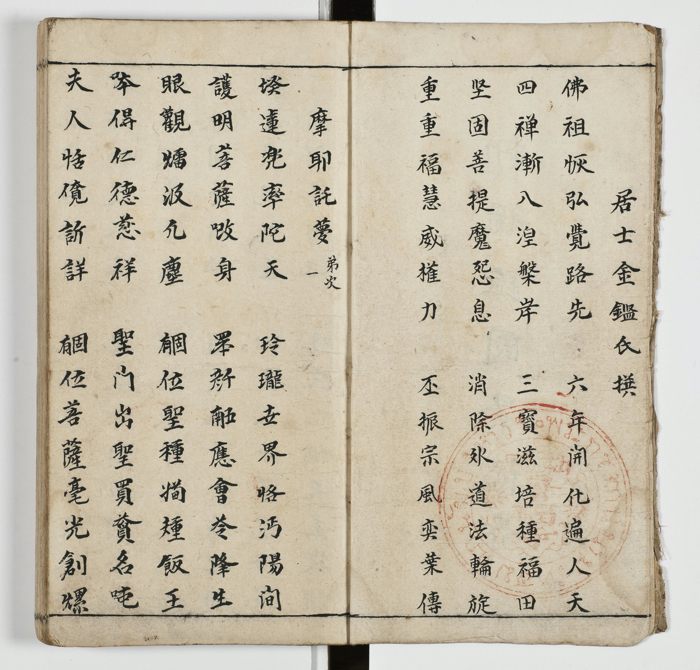- Project Leader : Kameyama Takahiko (Ryukoku University, Research Center for World Buddhist Cultures)
Outline of Research
The mainstream of Buddhism in Southeast Asia has been Theravada Buddhism, which stems from the Mahāvihāra tradition. This does not mean, however that there are no Buddhist traditions other than Theravada in Southeast Asian countries such as Myanmar, Cambodia, Thailand, and Laos. As Yumio Sakurai discussed in his paper, some Buddhist temples in Thailand have inherited the collections of Mahayana Buddhist scriptures and ritual manuals that were brought from China or Vietnam. The Hán-Nôm Buddhist Scriptures in Wat Samananam Borihan Temple, the main subject of this research project, are regarded as one such collection. I carefully examine these scriptures, which are currently preserved at the Center for Southeast Asian Studies, Kyoto University, in order to elucidate the reality of Mahayana Buddhism in Southeast Asia.
Description
This project investigates the doctrinal characteristics and historical significance of Mahayana Buddhist traditions of modern Southeast Asia. Specifically, I comprehensively examine the Hán-Nôm Buddhist Scriptures, which were brought from Vietnam to the Wat Samananam Borihan Temple in Bangkok during the nineteenth and twentieth centuries, and discuss how these scriptures functioned within the broader Buddhist communities in Thailand.
Theravada Buddhism, which stems from the Mahāvihāra tradition, was brought from Sri Lanka to Southeast Asia and spread widely across the region from eleventh to fourteenth centuries. This Buddhist tradition is currently regarded as the mainstream of Buddhism in Southeast Asia. This does not mean, however that other Buddhist traditions do not exist in Southeast Asian Buddhist countries such as Myanmar, Cambodia, Thailand, and Vietnam. For example, Thailand accepted the traditions of Vietnamese Mahayana Buddhism and Chinese Chan Buddhism respectively during the eighteenth and nineteenth centuries, and still maintains their temples in various areas. Within these Buddhist temples, Thai monks frequently utilize Chinese Buddhist scriptures and ritual manuals to pray for worldly benefits such as curing illness or maintaining peace. This pattern seems to explain how the collection of Hán-Nôm Buddhist Scriptures in the Wat Samananam Borihan Temple was organized.
Despite this rich history, few previous studies concerning Southeast Asian Mahayana Buddhism exist, due to its marginality in the region from both religious and political perspectives. With regard to the Mahayana Buddhist tradition in Thailand, a few scholars such as Sakurai have noted that although it has supported the spiritual lives of immigrants from China or Vietnam, its doctrinal background and historical significance is still unclear. In this research project, I carefully examine the Hán-Nôm Buddhist Scriptures of the Wat Samananam Borihan Temple to clarify the importance of such scriptures.
 Research activities at the CSEAS, Kyoto University |
 A part of the Chinese Vietnamese manuscripts in Cảnh Phước temple in Bangkok introduced by Yumio Sakurai (1945-2012) |
